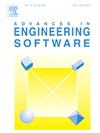Numerical investigation on fretting wear in steel wires by introducing system stiffness and dissipated friction energy
IF 5.7
2区 工程技术
Q2 COMPUTER SCIENCE, INTERDISCIPLINARY APPLICATIONS
引用次数: 0
Abstract
In the mining hoisting system, the reliability of wire ropes has a significant influence on the safety of the entire system. Subjected to coupled alternating stresses and small cyclic motions, fretting wear occurs in the internal steel ropes, leading to fatigue damage and reduced service life. Studying fretting behaviour through experiments is economically costly and cumbersome. This study numerically investigated the effects of system tangential stiffness (Ks), Crossing Angle (CA), and contact load (P) on fretting contact and wear behaviours of steel wires. Firstly, the fretting wear model for contact wires was established based on Archard’s wear model, and the accuracy of the model was compared with the published literature. Then, the fretting characteristics, such as wear morphology, relative slip amplitude (δa), and hysteresis loop, were investigated, and the action mechanism on wear depth was analysed. Finally, a more streamlined approach was proposed to predict wear depth by using dissipated friction energy. The results show that with an increase in the number of cycles, the relative slip amplitude gradually decreases, and non-Coulomb friction behaviour intensifies. The wear depth is influenced by the crossing angle and system stiffness mainly through the contact pressure and relative slip amplitude. Specifically, larger crossing angles and system stiffness result in more severe wear. An increase in contact load lead to a competition between contact pressure and relative slip, resulting in the initially increasing and then decreasing of wear depth. The effective dissipated friction energy, for the first time, was employed in wear prediction of steel wires. Compared to Archard's model, the prediction accuracy of the proposed model improves with the increasing system stiffness and the decreasing contact load. The proposed method offers a practical tool for wear prediction of steel wires, greatly enhancing the efficiency of wear calculations.
引入系统刚度和耗散摩擦能的钢丝微动磨损数值研究
在矿山提升系统中,钢丝绳的可靠性对整个系统的安全有着重要的影响。在交变应力和小周期运动耦合作用下,钢索内部发生微动磨损,导致疲劳损伤,降低使用寿命。通过实验研究微动行为在经济上既昂贵又繁琐。本文研究了系统切向刚度(Ks)、交叉角(CA)和接触载荷(P)对钢丝微动接触和磨损行为的影响。首先,基于Archard磨损模型建立了接触导线微动磨损模型,并与已有文献进行了精度比较;研究了微动磨损形态、相对滑移幅值(δa)和磁滞回线等微动特性,分析了微动对磨损深度的作用机理。最后,提出了一种利用耗散摩擦能预测磨损深度的简化方法。结果表明:随着循环次数的增加,相对滑移幅值逐渐减小,非库仑摩擦行为加剧;磨损深度主要通过接触压力和相对滑移幅值受交叉角和系统刚度的影响。具体来说,较大的交叉角和系统刚度会导致更严重的磨损。接触载荷的增大导致接触压力和相对滑移之间的竞争,导致磨损深度先增大后减小。首次将有效耗散摩擦能用于钢丝的磨损预测。与Archard模型相比,该模型的预测精度随着系统刚度的增大和接触载荷的减小而提高。该方法为钢丝的磨损预测提供了实用工具,大大提高了磨损计算的效率。
本文章由计算机程序翻译,如有差异,请以英文原文为准。
求助全文
约1分钟内获得全文
求助全文
来源期刊

Advances in Engineering Software
工程技术-计算机:跨学科应用
CiteScore
7.70
自引率
4.20%
发文量
169
审稿时长
37 days
期刊介绍:
The objective of this journal is to communicate recent and projected advances in computer-based engineering techniques. The fields covered include mechanical, aerospace, civil and environmental engineering, with an emphasis on research and development leading to practical problem-solving.
The scope of the journal includes:
• Innovative computational strategies and numerical algorithms for large-scale engineering problems
• Analysis and simulation techniques and systems
• Model and mesh generation
• Control of the accuracy, stability and efficiency of computational process
• Exploitation of new computing environments (eg distributed hetergeneous and collaborative computing)
• Advanced visualization techniques, virtual environments and prototyping
• Applications of AI, knowledge-based systems, computational intelligence, including fuzzy logic, neural networks and evolutionary computations
• Application of object-oriented technology to engineering problems
• Intelligent human computer interfaces
• Design automation, multidisciplinary design and optimization
• CAD, CAE and integrated process and product development systems
• Quality and reliability.
 求助内容:
求助内容: 应助结果提醒方式:
应助结果提醒方式:


